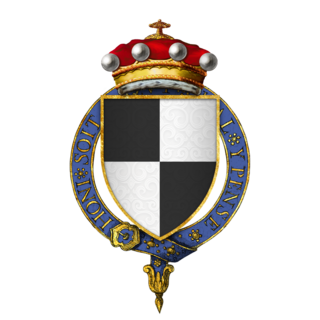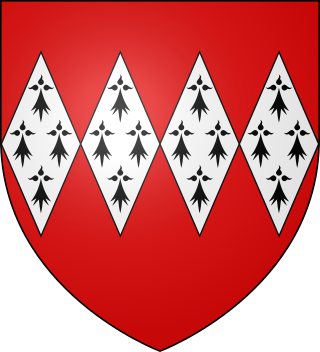Related Research Articles
Bartholomew de Badlesmere, 1st Baron Badlesmere was an English soldier, diplomat, member of parliament, landowner and nobleman. He was the son and heir of Sir Gunselm de Badlesmere and Joan FitzBernard. He fought in the English army both in France and Scotland during the later years of the reign of Edward I of England and the earlier part of the reign of Edward II of England. He was executed after participating in an unsuccessful rebellion led by Thomas, 2nd Earl of Lancaster.

Chivery is a hamlet located in the Chiltern Hills in the present-day parish of Aston Clinton, in Aylesbury Vale District in the county of Buckinghamshire, England. Chivery's southern boundary is formed by the ancient earthworks known as Grim's Ditch. To the north it is bounded by Wendover Woods.

John de Warenne, 7th Earl of Surrey, was the last Warenne Earl of Surrey.

Nicholas de Crioll, of a family seated in Kent, was Constable of Dover Castle and Keeper of the Coast during the early 1260s. His kinsman Bertram de Criol had distinguished himself in these offices during the preceding 20 years and both were near predecessors of the eminent Warden of the Cinque Ports, Stephen de Pencester.

Thomas Hoo, was an English landowner, courtier, soldier, administrator and diplomat who was created a Knight of the Garter in 1446 and Baron Hoo and Hastings in 1448 but left no son to inherit his title.
Sir William Boleyn, KB of Blickling Hall in Norfolk and Hever Castle in Kent, was a wealthy and powerful landowner who served as Sheriff of Kent in 1489 and as Sheriff of Norfolk and Suffolk in 1500. He was the father of Thomas Boleyn, 1st Earl of Wiltshire, whose daughter was Queen Anne Boleyn, the second wife of King Henry VIII.
Sir William Hawte was a prominent member of a Kentish gentry family of long standing in royal service, which, through its near connections to the Woodville family, became closely and dangerously embroiled in the last phases of the Wars of the Roses.

Sir William Denys of Dyrham, Gloucestershire, was a courtier of King Henry VIII and High Sheriff of Gloucestershire in 1518 and 1526. The surname is sometimes transcribed as Dennis.
Sir Nicholas Haute, of Wadden Hall (Wadenhall) in Petham and Waltham, with manors extending into Lower Hardres, Elmsted and Bishopsbourne, in the county of Kent, was an English knight, landowner and politician.
An Inquisition post mortem is an English medieval or early modern record of the death, estate and heir of one of the king's tenants-in-chief, made for royal fiscal purposes. The process of making such inquisition was effected by the royal escheators in each county where the deceased held land. The earliest inq.p.m. was made in 1236, in the reign of King Henry III (1216–1272), and the practice ceased c. 1640, at the start of the English Civil War, and was finally abolished by the Tenures Abolition Act 1660, which ended the feudal system.

Sir John Dinham (1406–1458) was a knight from Devonshire, England. His principal seats were at Nutwell and Kingskerswell in South Devon and Hartland in North Devon.
William Gage was an English landowner and the father of the Tudor courtier John Gage.
Sir John Gage was a major English landowner and grandfather of the Tudor courtier Sir John Gage KG.
Sir Philip St Clere was a son of Sir Philip St Clere of Ightham, Kent and Little Preston, Northamptonshire & his wife Joan de Audley. He served as High Sheriff of Surrey and Sussex and was a major landowner whose estates included land in eight English counties.
Sir Nicholas de Loveyne was a major English property owner and courtier, who held a number of senior positions in the service of King Edward III.

Sir John de Pulteney was a major English entrepreneur and property owner, who served four times as Lord Mayor of London.
Nicholas Gainsford, also written Gaynesford or Gaynesforde, of Carshalton, Surrey, of an armigerous gentry family established at Crowhurst, was a Justice of the Peace, several times Member of Parliament and High Sheriff of Surrey and Sussex, Constable and Keeper of Odiham Castle and Park, Hampshire, who served in the royal households from around 1461 until his death in 1498. Rising to high office during the reign of Henry VI, he was an Usher to the Chamber of Edward IV and, by 1476, to his queen Elizabeth Woodville. Closely within the sphere of Woodville patronage, he was a favourer of Edward V, and was a leader in the Kentish rising of 1483 against Richard III. He was attainted in 1483, but was soon afterwards pardoned, and fully regained his position and estate as Esquire to Henry VII and Elizabeth of York after the Battle of Bosworth Field. He established the Carshalton branch of the Gainsford family.

Sir Thomas de Felton was an English landowner, military knight, envoy and administrator. He fought at the Battle of Crécy in 1346, and the Capture of Calais in 1347. He was also at the Battle of Poitiers in 1356. A recurrent figure in the Chronicles of Jean Froissart, he was a signatory to the Treaty of Brétigny in 1360. In 1362 he was appointed Seneschal of Aquitaine. He accompanied Edward the Black Prince on his Spanish campaign. He was taken prisoner by Henry of Trastámara's forces in 1367. In 1372 he was appointed joint-governor of Aquitaine and seneschal of Bordeaux. He caused Guillaume de Pommiers and his secretary to be beheaded for treason in 1377. He was invested a Knight of the Garter in 1381.
Sir Arthur Hopton of Cockfield Hall in Yoxford, Suffolk was an English knight, landowner, magistrate, and Member of Parliament.
Sir Edward de Warren was an illegitimate son of John de Warenne, 7th Earl of Surrey by his mistress Maud de Nerford of Norfolk. He was lord of the manor of Skeyton and also held other lands in Norfolk. His son Sir John de Warren was the first of this surname to succeed to the manors of Stockport and Poynton in Cheshire, and Woodplumpton in Lancashire.
References
- ↑ Calendar of Inquisitions Miscellaneous (Chancery), Vol. 8, Nos. 114-117.
- ↑ Calendar of Inquisitions Miscellaneous (Chancery), Vol. 8, Nos. 114-117.
- ↑ Gage, John (1822). The History and Antiquities of Hengrave, in Suffolk. London. pp. 225–6.
- ↑ Calendar of the Patent Rolls, Reign of Henry VI, Vol. 4, page 443.
- ↑ Gage, John (1822). The History and Antiquities of Hengrave, in Suffolk. London. p. 228.
- ↑ Calendar of Inquisitions Post Mortem, 2nd series, Vol. 2, No. 210.
- ↑ 'Parishes: Kingsdown', The History and Topographical Survey of the County of Kent: Volume 2 (1797), pp. 475-493. URL: http://www.british-history.ac.uk/report.aspx?compid=62829 Date accessed: 01 February 2014.
- ↑ 'The parishes of Aylesbury hundred: Aston Clinton', A History of the County of Buckingham: Volume 2 (1908), pp. 312-319. URL: http://www.british-history.ac.uk/report.aspx?compid=62779 Date accessed: 01 February 2014.
- ↑ The National Archives: C140/52/26.
- ↑ Calendar of the Fine Rolls, Vol. 21, No. 322.